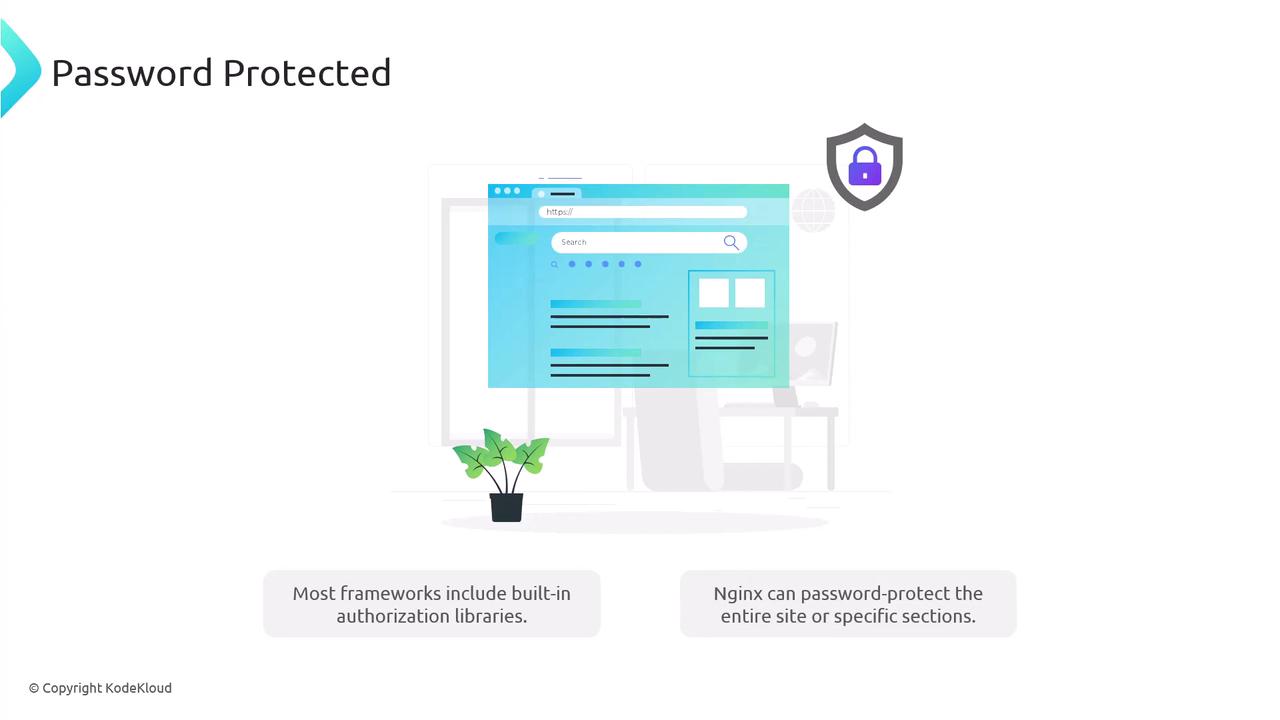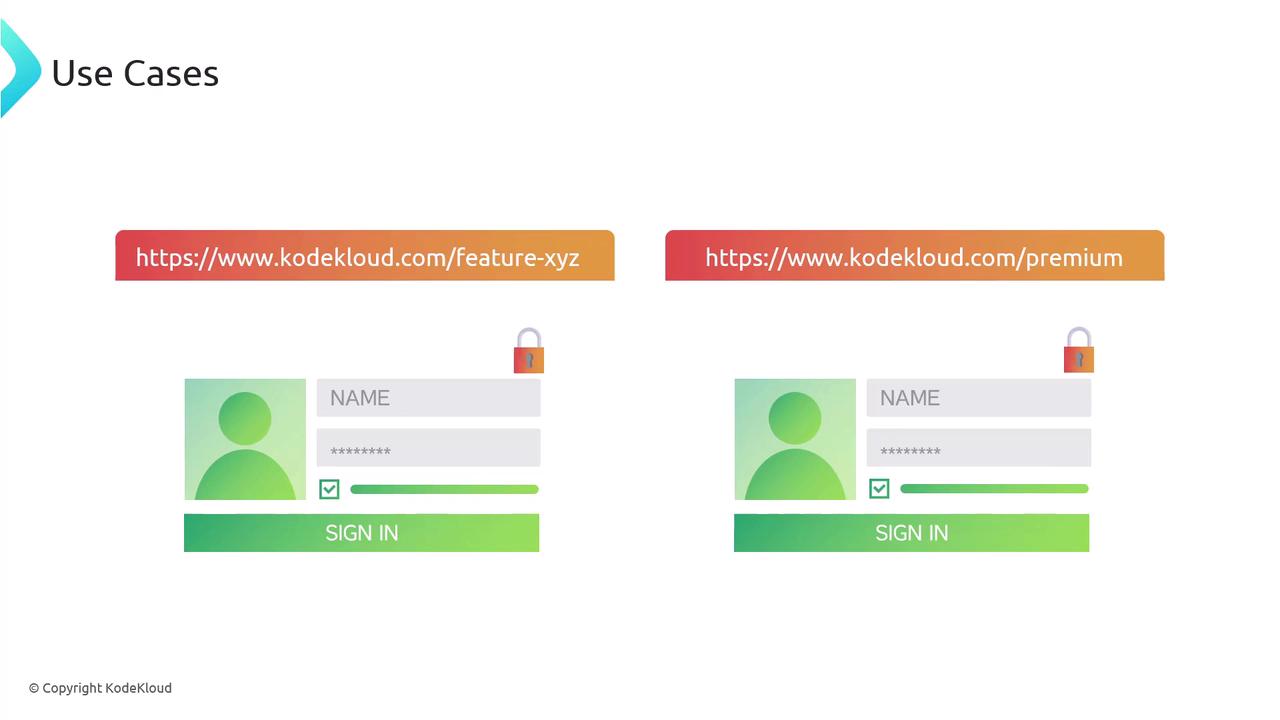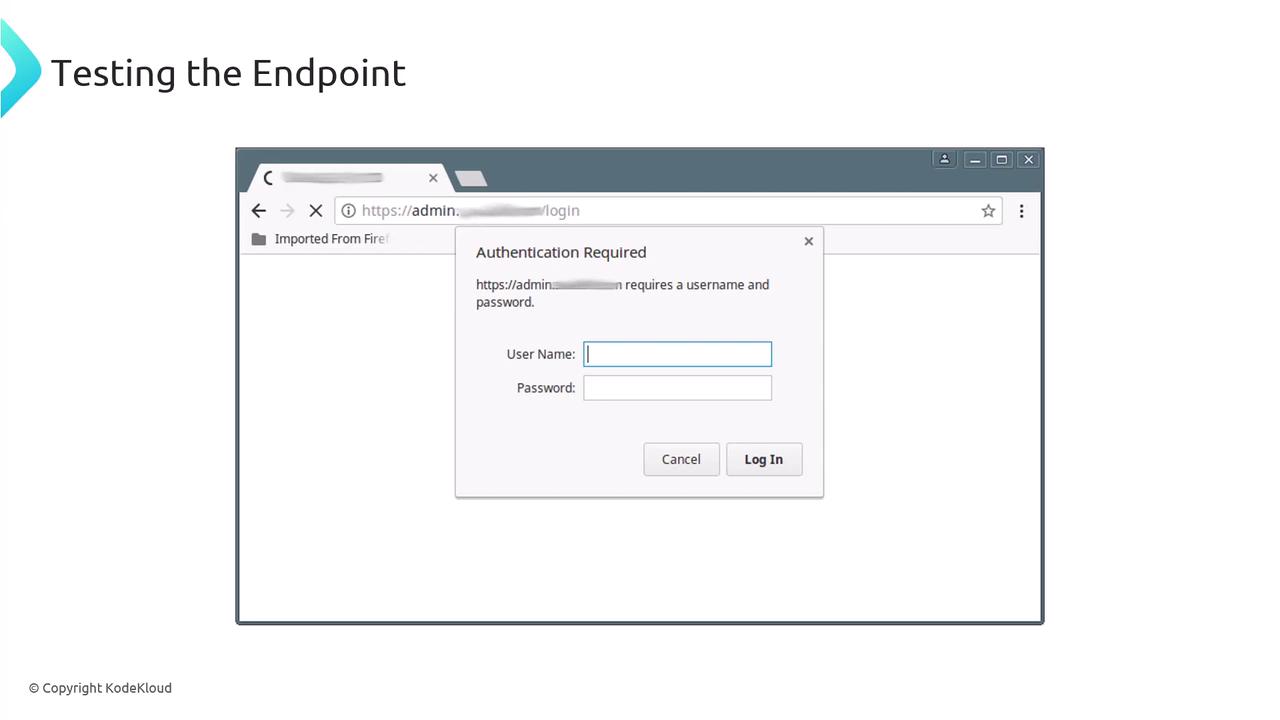Nginx For Beginners
Security
Basic Authentication
Nginx offers a straightforward way to secure parts of your website—such as admin panels, staging previews, or premium sections—using HTTP basic authentication. Only users with valid credentials can access protected resources, while the rest of your site remains publicly available.

For example, anyone can browse the public pages of kodekloud.com, but visiting kodekloud.com/admin will trigger a browser login prompt:

Warning
HTTP basic authentication sends credentials encoded in Base64, not encrypted. Use it only within trusted networks (VPN or internal LAN). For public-facing apps, consider OAuth, JWT, or framework-native authentication for better security and user experience.
1. Generate the Password File (.htpasswd)
You can create the .htpasswd file with either Apache’s utility or OpenSSL. Store this file in a secure directory (e.g., /etc/nginx/conf.d/).
| Method | Requirement | Usage Example |
|---|---|---|
Apache htpasswd | apache2-utils or httpd-tools | Add users with a prompt |
| OpenSSL | Built-in on most systems | Manually append hashes |
1.1 Using Apache’s htpasswd
# Install the tool if needed
sudo apt-get install apache2-utils # Debian/Ubuntu
sudo yum install httpd-tools # RHEL/CentOS
# Create a new file and add the first user
sudo htpasswd -c /etc/nginx/conf.d/.htpasswd admin
# Add additional users (omit -c to avoid overwriting)
sudo htpasswd /etc/nginx/conf.d/.htpasswd jsmith
# Enter and confirm password
1.2 Using OpenSSL
# For each user, append "username:" then an APR1-hashed password
sudo sh -c "echo -n 'admin:' >> /etc/nginx/conf.d/.htpasswd"
sudo sh -c "openssl passwd -apr1 >> /etc/nginx/conf.d/.htpasswd"
sudo sh -c "echo -n 'jsmith:' >> /etc/nginx/conf.d/.htpasswd"
sudo sh -c "openssl passwd -apr1 >> /etc/nginx/conf.d/.htpasswd"
# Enter and verify password
Note
Once hashed, plain-text passwords cannot be recovered. Store them securely using a password manager like LastPass or a secrets vault (e.g., HashiCorp Vault).
To confirm your .htpasswd entries:
cat /etc/nginx/conf.d/.htpasswd
# admin:$apr1$egX1fPMK$EXwGqVFsOSBFsQNJMc2iB0
# jsmith:$apr1$L5aCfsuk$XPsXgl1JMTQpd0ihTVyus.
2. Configure Nginx to Require Authentication
Edit your server block (commonly in /etc/nginx/sites-available/ or /etc/nginx/conf.d/) to protect a specific location, such as /admin:
server {
listen 80;
server_name example.com www.example.com;
root /var/www/example.com/html;
index index.html;
location /admin {
auth_basic "Restricted Content";
auth_basic_user_file /etc/nginx/conf.d/.htpasswd;
}
}
- auth_basic: Text shown in the browser’s login dialog.
- auth_basic_user_file: Path to your
.htpasswdfile.
Save the file, test your configuration, and reload Nginx:
sudo nginx -t
sudo systemctl reload nginx
When you navigate to http://example.com/admin, a login popup appears:

3. Next Steps & References
A live demo will follow, showcasing each step in action. In the meantime, explore these resources to deepen your understanding:
| Resource | Link |
|---|---|
| Nginx Official Documentation | https://nginx.org/en/docs/http/ngx_http_auth_basic_module.html |
Apache htpasswd Guide | https://httpd.apache.org/docs/2.4/programs/htpasswd.html |
| OpenSSL Password Hash Options | https://www.openssl.org/docs/man1.1.1/man1/openssl-passwd.html |
| OAuth 2.0 Overview | https://oauth.net/2/ |
For further reading:
Watch Video
Watch video content